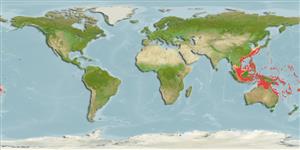Environment: milieu / climate zone / depth range / distribution range
Ekologi
marina revassocierade; djupintervall 2 - 150 m (Ref. 9710). Tropical; 34°N - 36°S, 99°E - 174°W (Ref. 5222)
Western Pacific: southern Japan to southern Queensland and east to Fiji and the islands of Micronesia. Recently recorded from Tonga (Ref. 53797). Record from Western Australia in the Indian Ocean is dubious. Replaced by Epinephelus flavocaeruleus in the Indian Ocean (Ref. 37816).
Length at first maturity / Size / Vikt / Age
Maturity: Lm ?, range 64 - ? cm
Max length : 122 cm TL hane/ej könsbestämd; (Ref. 4787); publicerad maxvikt: 17.3 kg (Ref. 40637)
Taggstrålar i ryggfenan (totalt) : 11; Mjukstrålar i ryggfenan (totalt) : 16 - 17; Taggstrålar i analfenan: 3; Mjukstrålar i analfenan: 8. Juveniles are mostly yellow becoming gray with dark spots anteriorly. The gray area increases with increasing size until only the fins remain yellow on individuals of 15 to 20 cm (Ref. 37816).
Usually found around isolated coral heads in lagoons or bays, but also caught on outer reef area. According to Myers (1989, Ref. 4538) it usually swims out in the open, several meters above the bottom. It is readily caught by anglers at night. Feeds mainly on sand-dwelling fishes and crustaceans such as snake eels and box crabs. In Hong Kong live fish markets (Ref. 27253).
Life cycle and mating behavior
Maturities | Reproduktion | Spawnings | Egg(s) | Fecundities | Larver
Heemstra, P.C. and J.E. Randall, 1993. FAO Species Catalogue. Vol. 16. Groupers of the world (family Serranidae, subfamily Epinephelinae). An annotated and illustrated catalogue of the grouper, rockcod, hind, coral grouper and lyretail species known to date. Rome: FAO. FAO Fish. Synop. 125(16):382 p. (Ref. 5222)
IUCN Red List Status (Ref. 130435)
Threat to humans
Reports of ciguatera poisoning (Ref. 1602)
Human uses
Fiskeri: mindre kommeriell; Akvarium: Offentliga akvarier
Verktyg
Special reports
Download XML
Internet-källor
Estimates based on models
Preferred temperature (Ref.
123201): 22.5 - 29, mean 27.8 °C (based on 1250 cells).
Phylogenetic diversity index (Ref.
82804): PD
50 = 0.5000 [Uniqueness, from 0.5 = low to 2.0 = high].
Bayesian length-weight: a=0.01122 (0.00705 - 0.01786), b=3.05 (2.92 - 3.18), in cm total length, based on LWR estimates for this species & Genus-body shape (Ref.
93245).
Trofisk nivå (Ref.
69278): 4.1 ±0.5 se; based on diet studies.
Resiliens (Ref.
120179): Mycket låg, lägsta populationsfördubblingstid mer än 14 år (Preliminary K or Fecundity.).
Fishing Vulnerability (Ref.
59153): High to very high vulnerability (73 of 100).
Nutrients (Ref.
124155): Calcium = 15.1 [7.2, 34.0] mg/100g; Iron = 0.448 [0.226, 0.897] mg/100g; Protein = 18.4 [16.8, 19.9] %; Omega3 = 0.112 [0.067, 0.188] g/100g; Selenium = 51 [27, 103] μg/100g; VitaminA = 192 [50, 735] μg/100g; Zinc = 0.956 [0.646, 1.371] mg/100g (wet weight);
